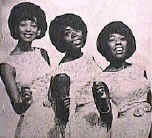Bach's Minuet in G
 |
The ToysLeft to right: June Montiero, Barbara Parritt, and Barbara Harris |
From the website http://www.history-of-rock.com/toys.htm --
In 1964 they were signed by the Publishing firm Genius, Inc., which teamed them with the songwriting duo Sandy Linzer and Denny Randell.... The writers took a classical finger exercise from Bach and put a Motown bassline to it and "A Lover's Concerto" was born.
September 1965: "A Lover's Concerto" on the Dynavoice label went #4 R&B, crossed over to pop charts #2, and also became a #5 hit in England. In 1965 the song sold over a million copies. The Toys began appearing on television shows such as "Shindig!," "Hullabullo," and "American Bandstand," toured with Gene Pitney, and appeared in the film It's a Bikini World.
Other sites giving further details on Bach's Minuet in G:
Search for the sheet music and a rendition of the work at codamusic.com's Finale Showcase Search Page.
Seeing and hearing the music on this site requires that you download Coda's SmartMusic Viewer, and possibly requires that you adjust your browser settings, depending on the operating system you use.
For another look at Bach's music, along with a midi rendition, you can download Music MasterWorks composing software from the Aspire Software site...
http://www.musicmasterworks.com/.
Then download the midi file of the Minuet in G itself, "Minuet in G, BWV841" (M.Lombardi), from the website
http://www.classicalarchives.com/bach.html.
(To do this, right-click on the minuet link and use the "Save Target As" option, if you, like me, are using Internet Explorer with Windows.)
After you have downloaded the midi file of the minuet, use the "File" and "Open" options in Music MasterWorks to display and play the music.
A comparison of these two versions of Bach is instructive for anyone planning to purchase music composition software. The MasterWorks creates sheet music from its midi file that is quite sophisticated and rather hard to follow, but this music accurately reflects the superior musical performance in the downloaded midi file versus the rendition in the online Finale Showcase file. The Showcase file is much simpler and easier to read, as the rendition it describes is also quite simple.
The Gentle Rain
For an even simpler version, those of us who were in our salad days in 1965 can consult our memories of The Toys:
How gentle is the rain
That falls softly on the meadow.
Birds high up in the trees
Serenade the clouds with their melodies.
Oh, see there beyond the hill,
The bright colors of the rainbow.
Some magic from above
Made this day for us just to fall in love.
Those of the younger generation with neither the patience nor the taste to seek out the original by Bach may be content with the following site --
To a more mature audience, the picture of a Venetian sunset at the above site (similar to the photo below, from Shunya's Italy)

will, together with the lyrics of The Toys, suggest that
The quality of mercy is not strained.
It droppeth as the gentle rain from heaven....
This line, addressed to Shylock in "The Merchant of Venice," contradicts, to some extent, the statement by Igor Stravinsky in The Poetics of Music (1942, English version 1947) that music does not express anything at all. Stravinsky is buried in Venice.
From Famous Graves:

Igor Stravinsky,
Venice







